Camp Mercer 660th Company S-79, a Civilian Conservation Corps Camp
Introduction
Text-to-speech Audio
Camp Mercer or 660th Company S-79 operated along the banks of the Manitowish River from 1933-1942. Camp Mercer utilized the rail depot at Manitowish, Wisconsin to logistically support the development and maintenance of the Civilian Conservation Corps camp one mile west of the Iron and Vilas county line. 660th Company stands out as a larger regional administrative CCC camp. Historically, some area residents confused the site of the North Lakeland Discovery Center as the site for CCC Company 660th. The Youth Conservation Camp, known as Statehouse Lake in Manitowish Waters, was created in 1962 as a separate state program, with a mission that paralleled that of the earlier CCC.
A trail features 23 interpretive signs, and a 3.5 mile hike will guide visitors through Camp Mercer and other cultural sites. Check web links below for further details. Paper trail maps are available at the trailhead, bike trail bridge, and trail gate by the Highway 51 wayside.
It is illegal to dig or take artifacts on public lands without a permit from the DNR Archaeologist and State Archaeologist. Camp Mercer and other cultural sites like logging camps are even more protected because they are recorded on the Wisconsin Archaeological Site Inventory. Observing, taking photos and sharing stories around Camp Mercer are encouraged.
Images
Camp Mascot Diane the deer
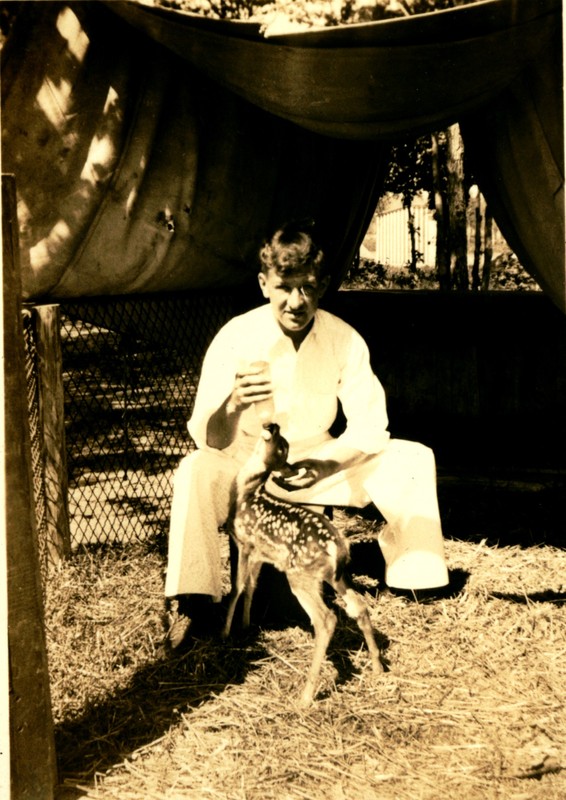
Camp Mercer Baseball Team
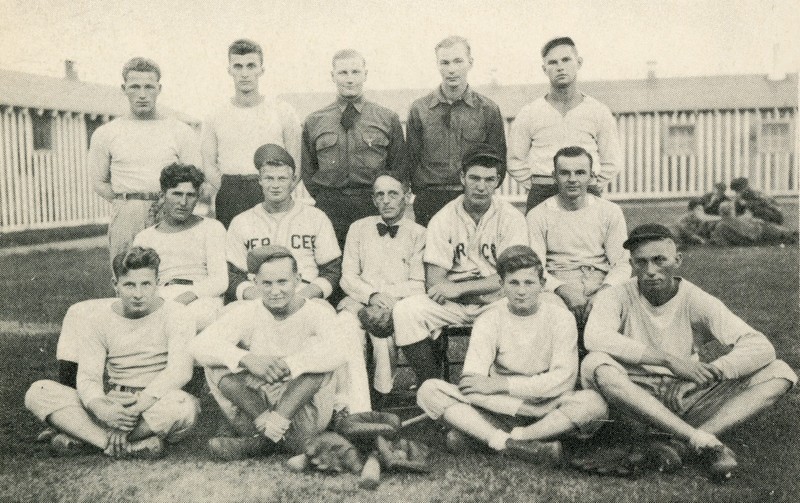
River view of Camp Mercer early construction
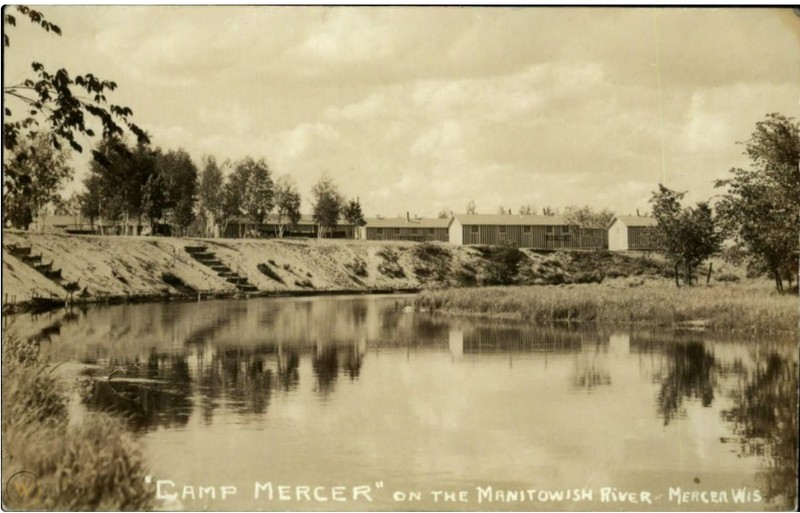
Aerial view of Camp Mercer

Camp Mercer men going to work in the state forest
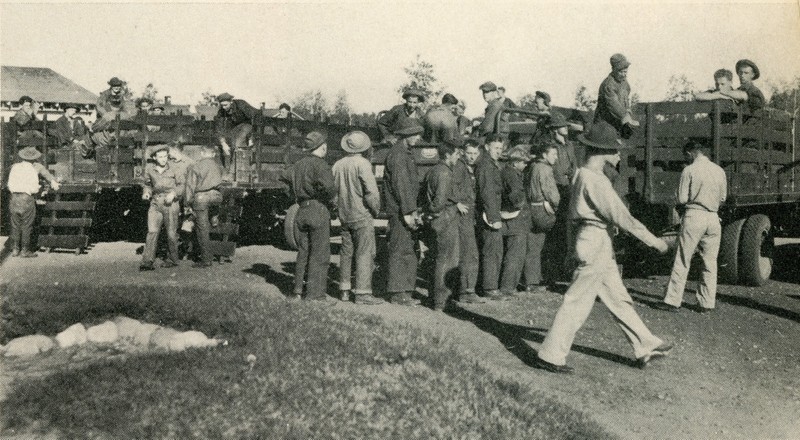
CCC dynamite shack still standing on the Camp Mercer Trail
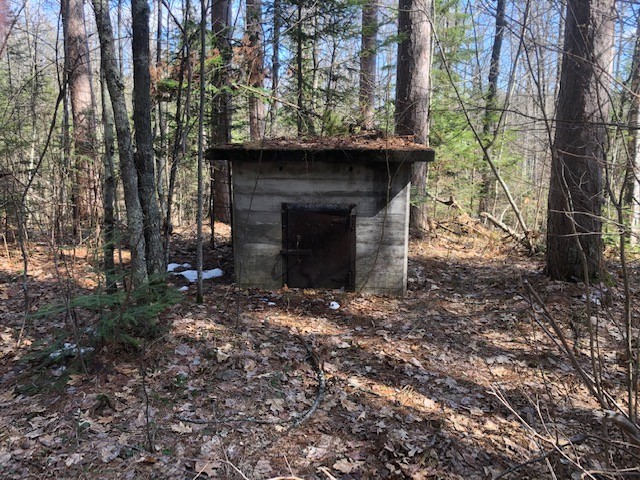
Camp Mercer main gate
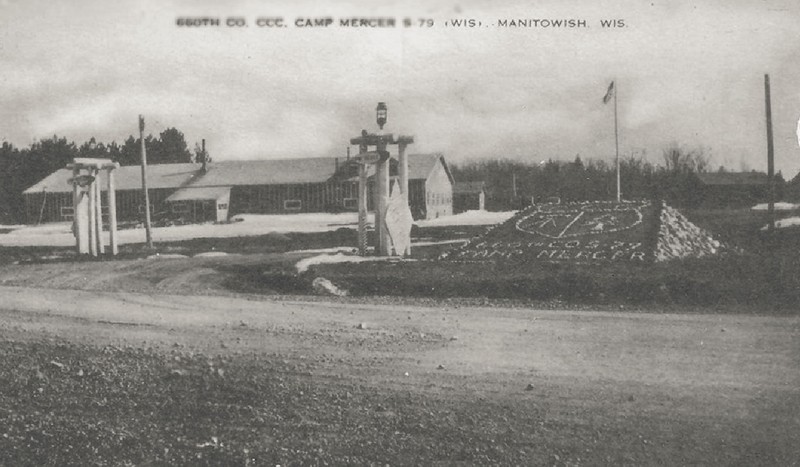
Rangers and CCC men running to put our a forest fire
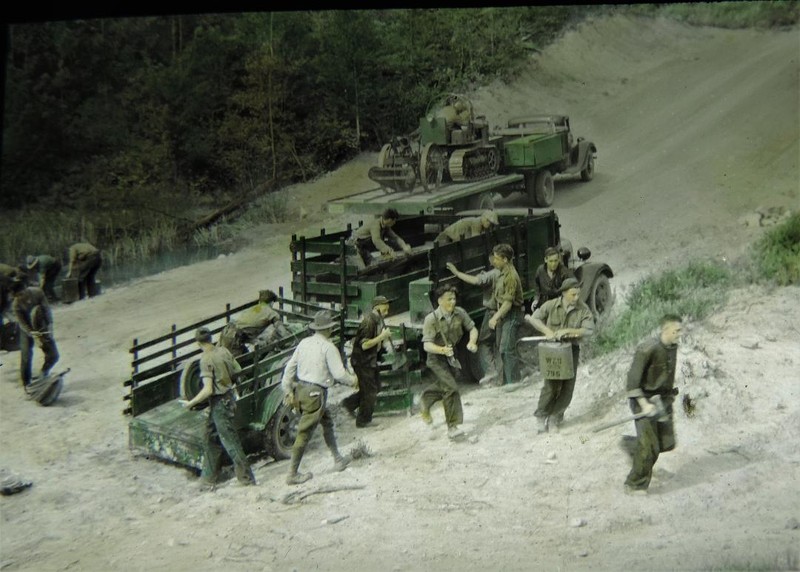
Sunburned CCC workers on telephone pole detail
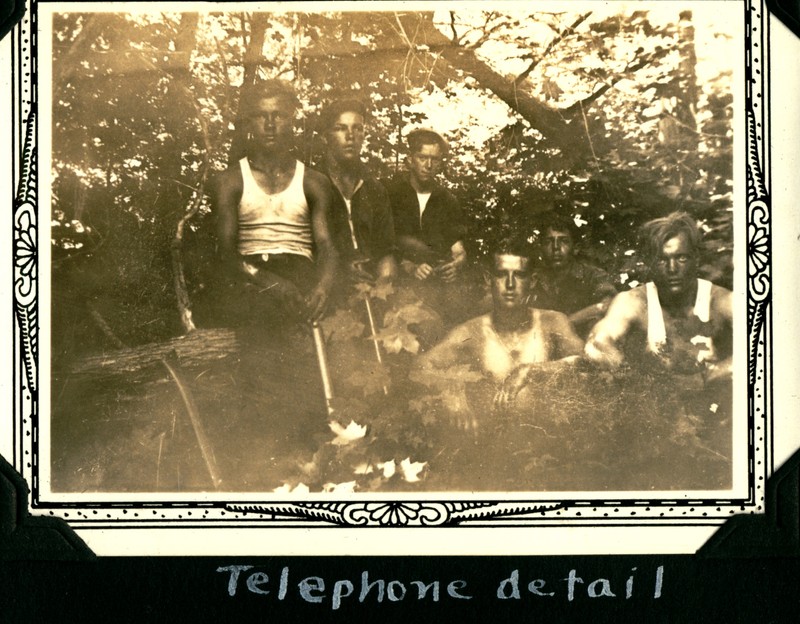
Snowshoes were need for winter work
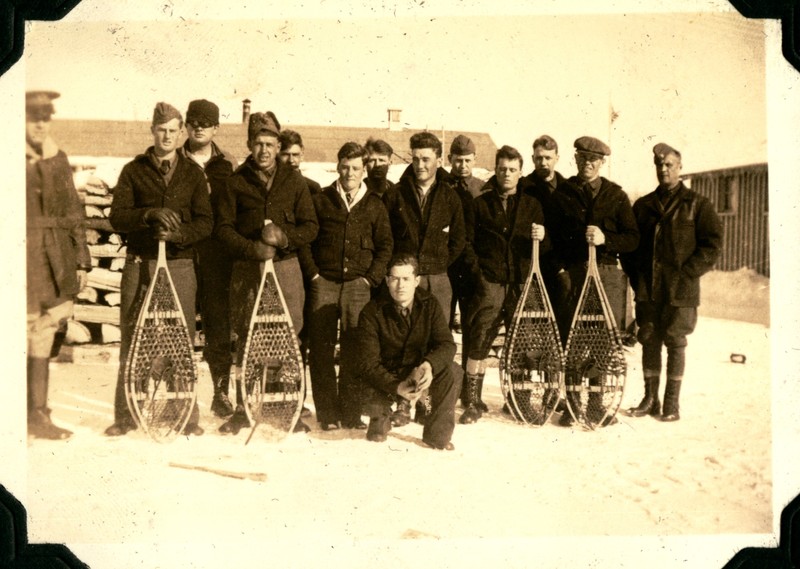
Snow plowing was challenging and necessary to conduct winter work details.
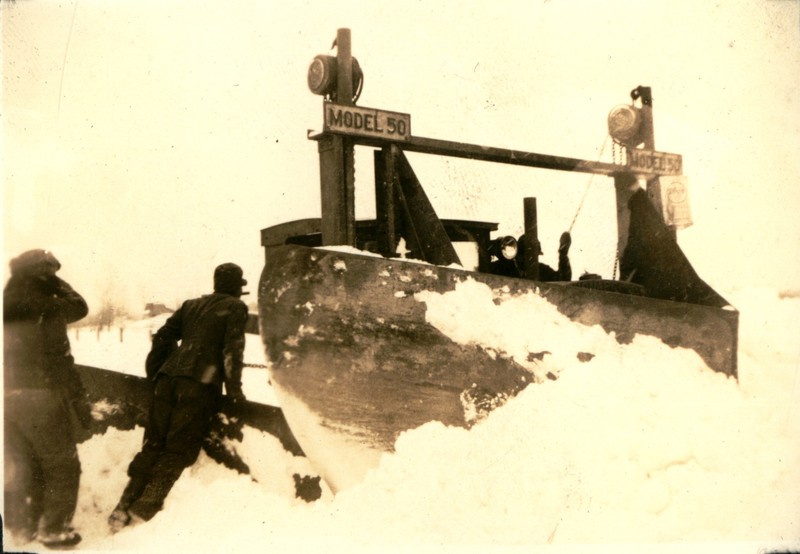
Backstory and Context
Text-to-speech Audio
In 1933, the first men arrived on the banks of the Manitowish River, spending their first months pitching tents, clearing land, and planning basic construction to prepare for winter. Under the leadership of Lieutenant Ellis and Mr. V. A. Moon (Forestry Superintendent), the men of 660th Company overcame significant challenges in the construction phase of the camp. These pioneers of 660th Company were proud of the rugged conditions they overcame, whether bathing in the river or enduring zero-degree temperatures in tents. 660th Company history reveals that these young men, “…took it with a smile being ever thoughtful that they were doing something instead of staying at home and having nothing to do." Signing up for six-month terms of service, the earliest men at Camp Mercer were revered by later enrollees as being “tough-as-nails.” Their pride was evident, because they had broken the grip of hopelessness that plagued many Americans during the Great Depression.
CCC 660th Company was perfectly situated on the western edge of the Northern Highland Forest, and personnel eagerly fulfilled their mission as State Forestry CCC Camp S-79. “Camp Mercer, being situated on the banks of the beautiful Manitowish in the heart of the lake and forest regions, necessarily was assigned many and varied work projects.” Easy access to old Highway 51 (previously Hwy 10) and the Chicago Northwestern Railroad at the Manitowish Depot allowed 660th Company strong logistical support and quicker travel throughout the region when compared to other CCC camps.
CCC 660th Company’s permanent status and large size and scope evidences its ultimate role as an administrative CCC camp that provided special services and oversight to other CCC camps. On June 12th, 1935, 100 men from 660th Company were assigned to Superior, Wisconsin to create CCC Company 3663. The budding CCC Company 3663 remained on the banks of the Manitowish River, preparing for the journey to Superior until July 19th, 1935.
Our archives of 41 Mercer Monitor camp newspapers identify over 190 different Wisconsin communities that sent men to Camp Mercer. Virtually every corner of the state contributed men to this national conservation effort. Additionally, men from Michigan, Illinois and Missouri were enrollees at CCC 660th Company S-79.
By 1935, Camp Mercer became the headquarters for the 5th Forestry Subdivision District and housed a district commander from Sparta, Wisconsin. Initially, eight camps composed the district: Camp Mineral-Lake Marengo; Camp Brinks-Washburn; Camp Upson-Upson; Camp Crystal Lake-Star Lake; Camp Phelps-Phelps; Camp Nine Mile-Eagle River; Camp Star Lake-Star Lake; and Camp Mercer-Manitowish. Later in 1935, two more camps were added to the 5th Forestry Subdivision District: Camp Copper Falls-Mellen and Camp Morse-Morse. Likely, Camp White Sands-Boulder Junction was also added to the 5th Forestry Subdivision District.
In early 1936, 660th Company established a radio station, WUGF. “…1936, four Clough-Brengle 28 watt radio transmitters were shipped to the Sparta CCC District for the purpose of establishing a radio net for the handling of official messages and affording an opportunity for educational and vocational training for the CCC enrollees. These four transmitters were placed at Sparta, Blackwell, Mercer and Cable, with the respective call letters WUGD, WUGE, WUGF and WUGG.” Again, the leadership at 660th Company was extended important regional communication and educational responsibilities. Signal officers were responsible for transmitting key information to the Net Control Station at Sparta headquarters. Camp Mercer’s Glee Club, musicians and Forensic Club broadcasted plays and musical programs both from Camp Mercer on WUGF and Ironwood on WJMS. In October of 1934, the Camp Mercer Forensic Club created a radio drama of a typical day of fighting fires in the Northwoods.
All of the field activities and projects conducted at Camp Mercer were at the direction of state forest rangers. Interestingly, the activities of the State Forestry CCC camps in the 1930s and early ‘40s paralleled the work of the Wisconsin Department of Forestry from 1904-1915. Logically, the insightful work of Wisconsin’s first State Forester, E. M. Griffith, provided a proven template of best forestry practices. Consequently, Company 660’s:
“…work project set-up at the start of the camp program consisted of: Thirty-six miles of telephone line construction; seventy miles of telephone line maintenance, 5,000 acres of fire hazard reduction, twelve miles of roadside clean-up, fifty-one miles of stream improvement; sixty-two miles of fire lane construction; and thirty-three miles of fire lane maintenance.” At the time, fires plagued the Northwoods. Manitowish Waters contended with a series of fires in the Powell Marsh area that burned for years during the Great Depression and WWII.
Undoubtedly, 660th Company was one of the first responders to attack the fire-line, protecting communities and natural resources. Fires in the township of Sherman were also quite devastating. Manitowish Waters’ resident and Camp Mercer enrollee Carl Christensen recounted his role in battling fires in the Powell Marsh during the fierce fires of 1934:
"That fire swept up to the Powell Road. We fought with as much as we could fight with to keep it from going across Powell Road because it would have got into Manitowish and wiped out everything. …And they called the CC's in and the commander, what we wanted to do was backfire and the commander says no. He says you can't backfire because that's not legal. We have to put it out. All them CC boys was walking around with tanks on their backs with a squirt hose on so they could squirt on the edge. That was all right putting the fire out where there was a little edge on it. They couldn't get water. I was the only one there that had a legal blasting license to blast with dynamite. So what they had me do was blast holes in the marsh so they could get water. So the CC would pound up a hole and drill a hole down into the marsh maybe five or six feet or so and then I would load that with dynamite, set it off and then they would have an open crater there that would fill with water so they could get water for their tanks."
Company 660’s legacy illustrates a strong focus on fire: prevention, suppression and restoration. “This camp has completed the following work during the period June 20, 1933 to May 14, 1937: Forty-six miles of fire lane construction; five fire lookout towers constructed; one million trees planted (Norway, White Pine and Jack Pine); lake improvement of twenty-one lakes; transplanting of fish; fire suppression, fire pre-suppression and fire prevention all season.”
To support both the watch tower crews and conduct the regional work of Camp Mercer, three sub camps at Pine Lake, Springstead and east of Presque Isle on Oxbow Lake were established. These sub camps operated from late March until early December. Mostly tent camps, the sub camps were more rugged, and the men took great pride in their remote service. Today, fire towers, logging roads, mature trees, and quality lakes and streams are testimony to the long-term efforts of the CCC men.
In addition to traditional forestry projects, Camp Mercer engaged in fish rescue and fish habitat improvement. From 1929 through 1934, the Turtle Flambeau Flowage was suffering under a prolonged drought that dropped water levels as much as 14 feet. First, the surviving fish literally needed to be rescued by creating channels from isolated ponds to the rivers or by netting the fish. Next, the habitat of various lakes needed to be improved. Fish cribs, gravel spawning boxes, and shoreline and stream restoration were all part of 660th Company’s duties. This was especially true for the Springstead or Pine Grove sub camp.
A division of Camp Mercer also provided flood relief in the area around Anna, Illinois in 1936. In addition, they began cutting lanes for an 11,000-acre forest or game preserve just north of Camp Mercer and extended west to the town of Mercer and north to County Highway J. A fish hatchery and rearing pond near Big Lake and a rearing pond on Circle Lily Creek were completed in 1935. The Mercer Monitor documented the work of the “beavers.” “Bill Summers’, Ray Pripps’, Ed King’s crews are working like beavers to build a Dam and Fish Hatchery on Rice Creek and will have it completed by April 15, 35. How they do like their job.” The Camp Mercer “beavers” were busy. “Our dam and fish hatchery were completed ahead of time and is already to receive its quota of fish eggs.”
The Pine Lake sub camp did have a reputation of not rescuing turtles, rather making soup from these reptiles and inviting the forest rangers to join them in dining. Many other men hunted and fished while at Camp Mercer and when on leave.
Over the years, there were many calamities, which included vehicle breakdowns in remote areas like Moose Lake, capsized boats on the Turtle Flambeau Flowage (requiring CCC “boaters” to wait hours for rescue while clinging to old treetops in white caps), a dam blowout at the Circle Lily Creek rearing pond, the shower house burning down, and countless minor accidents involving trucks, cars and mechanized equipment. These events represent only a few blemishes on the record of 660th Company. Without a doubt, the greatest complaint from officers and enrollees were flies, ticks and mosquitoes.
Educational Programs were an important pillar of the CCC model. The Great Depression caused schools to close and/or children were unable to access public education for years. These educational gaps were strategically addressed through an array of CCC educational programs, meeting the varied learning needs of CCC participants:
“In April, 1934… inaugurated…academic and vocational courses. The academic field consisted of elementary, high school and college courses with recognized credit at local institutions. The vocational courses were many and varied. A few were: Typing, bookkeeping, agriculture, photography, leathercraft, woodworking, and auto mechanics.”
In May of 1934, a partial survey of educational levels at Camp Mercer revealed:
Number Finishing College 3
Number Finishing High School 51
Number Finishing 2 Yr. High School 24
Number Finishing 8th Grade 36
Number Finishing 6th Grade 19
Number Finishing 4th Grade 2
Number Taking Vocational, Apprenticeship, Correspondence and Graduate Work 18
Differentiated educational programs led to diverse outcomes for CCC men. Popularity of the educational programs at 660th Company was clearly evidenced in the 1937 Sixth Corp Area Annual. “The educational building has steadily grown from a meager eight-by-twelve-foot room to a full barracks, and has recently been revamped into one of the finest of CCC educational buildings.” Additionally, the 660th Company community published, “The camp newspaper, "Mercer Monitor," … founded May 2, 1934. Publication has been made regularly ever since.” Even in the earliest months of Camp Mercer, educational classes were available. As the camp grew, so did the educational offerings; and when Camp Mercer became an administrative camp in 1935, Educational Conferences for 5th Forestry Subdivision District were hosted along the banks of the Manitowish River. Early (May 1934) weekly course offerings from the Mercer Monitor:
Tuesday
Mapping and Surveying
Football methods
Higher Mathematics
Athletic Program
Wednesday
Trouble Shooting on a Gas Engine
Agriculture
Arithmetic
Penmanship and spelling
Thursday
Athletic program
Personal Hygiene and First Aid
Business English
Higher Mathematics
Friday
Athletic program
Agriculture
Alternating Religious Services
Slides by Conservation Dept.
Sadly, the CCC was politically attacked both nationally and locally by opponents of FDR’s New Deal. In 1934, the Mercer Monitor featured a defense of their efforts by offering “plain facts”:
“We who live at Camp Mercer and see the operation of the camp from day to day, feel that an injustice is been done given we hear our work criticized as is frequently done, and it is the object of the Monitor to make an effort to keep our readers informed as to the facts.
“A large percentage of the boys are engaged at present time battling a very dangerous fire, which would without a doubt cause terrific havoc with the small amount of timber the lumber men, of many years ago so generously left for those who followed. In this case of disasters forest fires, we ask any fair-minded person what would happen if we had no CCC boys and we are compelled to fall back on the scattered population for assistance and in many cases to save homes and lives?...
“Starting from camp at 5:00 AM, grabbing a few sandwiches sent out them and at it again (and what we say at it again we don't mean maybe) get back to camp at dark, sleep a few hours, and on the job again. When these boys are not fighting fires to save what little timber we have left in protecting the homes and lives of scattered settlers, they're cutting brush and clearing the land bordering the highways, which makes the stopping of fires more simplified. In addition to this work, fire lanes are being made 24 feet wide. A good turnpike is made, enabling firefighters to reach any fires they may be spotted by the lookout towers with the least possible delay. In many cases fires are reached in less than an hour after they are reported.”
Local businesses benefited from the CCC men spending part or all of their $5 a month going out on the town, particularly in the months of October through April when tourism was quite low. More important than the CCC men spending their money (less than 17 cents a day for their efforts) was the money they earned and sent home to their families, which was four to five times greater.
Like today, political wrangling and debates regarding the role of government raged as FDR’s New Deal created his “Alphabet Soup” reforms. But in the end, the American people elected FDR to four terms in office, consistently choosing direct relief, recovery and reform over “Hoovervilles” and “Hoover Blankets.” Even though FDR’s “Tree Army” of CCC men was popular, Northwoods camp closures started in 1937, and Camp Mercer was on the chopping block as well.
Athletics and outdoor recreation were other pillars of the CCC culture. Additionally, 660th Company “…achievements include athletic awards received, including the baseball championship of the Sparta CCC District for 1936.” Early in 1933, construction of the baseball diamond was cleared to provide vital recreation for the men. Today, the baseball field clearing is still visible, with young pine trees slowly reclaiming the field where Camp Mercer baseball champions once played.
In 1933 and early 1934, Camp Mercer competed athletically locally throughout the Northwoods, including at the CCC-Indian Division in Lac du Flambeau, Mercer, Little Bohemia Lodge, Boulder Junction and Rhinelander. By 1934, the competitions expanded more to the north against CCC camps located as far east as Iron River and Trout Creek, Michigan. In 1935, athletic conferences shifted to the 5th Forestry Subdivision camps, with competitions at Camp Mineral-Lake Marengo; Camp Brinks-Washburn; Camp Upson-Upson; Camp Crystal Lake-Star Lake; Camp Phelps-Phelps; Camp Nine Mile-Eagle River; Camp Star Lake-Star Lake; Camp Mercer-Manitowish; Camp Copper Falls-Mellen; and Camp Morse-Morse. Boxing was a popular sport, and matches in Ironwood, Rhinelander, Merrill and Milwaukee were especially featured in the camp newspaper.
Those not qualifying for the formal teams were strongly encouraged to compete by barracks in volleyball, football, kitten (soft)ball, basketball and sometimes boxing. Boxing also seemed to be a means by which disputes and rivalries were settled unofficially in camp. The Mercer Monitor had more than one account of CCC enrollees being pugilists to settle a score, much to the entertainment of the other camp members.
Recreational activities were often featured in the 1937 Sixth Corp Area Annual, showcasing baseball, swimming, archery, boxing, billiards, basketball, running, track and field, canoe jousting, softball and musical bands. In addition, church services were conducted at Camp Mercer, as well as more casual social activities, mostly at the camp canteen. Supplies and amenities were for sale at the “P EX,” or Post Exchange, to provide the men with necessities. In March 1935, beer was added to the soft drinks already offered at the canteen for refreshment. Proceeds from the canteen were used to purchase the men a washing machine. This was a tremendous upgrade to the washtubs and wash boards early enrollees used year-round.
Proper medical care was essential, considering the dangerous work and harsh conditions CCC men sometimes faced. CCC 660th Company had a dispensary for medical needs that was manned by a camp surgeon. Camp Mercer’s ambulance service responded to a variety of emergences that befell the men. Sadly, some Wisconsin CCC camps were plagued with diseases like spinal meningitis and higher accident rates. Mercer Monitor articles entitled “Infirmary Infections” or “Dispensary Infections” were an important part of the camp newspaper. Articles focused on prevention through awareness. Maladies like the flu, measles, poison ivy, burns from fighting fires, venereal diseases, mumps, frostbite, pneumonia and injuries from a wide range of work site accidents were addressed by the medical staff. Serious medical conditions and surgeries were treated at Grandview Hospital in Ironwood, Michigan.
Romantic interests of the men are revealed in nearly every issue of the Mercer Monitor. Camp morale was seemingly boosted by both overt and covert teasing regarding enrollees’ relationships. These men traveled far and wide to seek companionship, grab a drink and have a good time. CCC men’s camp antics were captured in ongoing articles and cartoons, “Hermit Club,” “Lovers Club,” “Laffs and Gaffs,” “Heard About Camp,” “Humor,” “Here and There,” and many more. Teasing and celebrating the lives of their CCC brothers reveal the subjects of camp banter but, more importantly, gives insight into how young men coped with the rigors of the Great Depression.
The CCC was a department of the U.S. Army and run accordingly, but men of 660th Company S-79 found time to have plenty of fun, too. "Rooks," or new enrollees, were subject to initiations, including snipe hunts. With most of their time spent in the field doing the work prescribed by the Wisconsin state forest rangers, CCC workers came in contact with abandoned baby animals. Camp mascots were an informal tradition. Most well-known was “Dianne” the deer, who was often requested by locals and visitors for photo opps. Additionally, the men of 660th Company also had a bear cub, rabbits, dogs and flying squirrels as part of their menagerie of critters. Fighting numerous fires each spring likely led to men from Camp Mercer discovering many animals injured and/or separated from their mothers. The private (unofficial) photo collection of Ambrose McKloskey also included images of CCC boys hunting and having beer parties in their barracks.
Unfortunately, Camp Mercer’s tenure was not without tragedy. On April 22nd of 1934, 660th Company leadership sent Eugene Bosineau and company cook John Morris to Little Bohemia on a beer run. They were driven to Little Bohemia by Mercer resident John Hoffman in his 1933 Chevy Coup. Unknowingly, these men found themselves in the middle of a standoff between the FBI and Public Enemy Number 1, John Dillinger, and his notorious gang. Just as FBI agents set a perimeter around Little Bohemia, the CCC men chose to return to Camp Mercer to complete their assigned mission. Bosineau and Hoffman had been drinking, but Morris was highly intoxicated and had just filled his flask at the bar. An FBI web page reports:
“Three of them got into a car and turned on the radio and began to drive off. Agents yelled ’Stop! Federal Agents! Police! Stop!’ But the men had been inside drinking, having a good time. They didn’t hear the agents. And because they seemed to be coming at them in a threatening manner, our agents opened up fire on the car.”
Morris fled the bullet ridden car, leaving Bosineau who was mortally wounded, to call Camp Mercer for the ambulance. Both Hoffman and Morris were also shot by law enforcement but survived. The FBI’s choice to open fire on Hoffman’s 1933 Chevy alerted Dillinger and his gang, leading to a gun fight, which allowed the criminals to escape.
Sadly, the most lethal member of the gang, Baby Face Nelson, fled a few miles east on Highway 51 to Koerner’s Resort. Nelson was ready for law enforcement and sprang on the two FBI agents and the Spider Lake (Manitowish Waters) constable as they drove into Koerner’s Resort. Spraying the car with bullets at point-blank range, Nelson killed FBI agent Carter Baum and seriously wounded both FBI agent Jay Newman and town constable Carl Christensen. It could be argued that a Camp Mercer “beer run” directly impacted Dillinger’s humiliating escape from federal agents and the FBI’s failure on the ground, directly leading to a systemic restructuring of FBI tactics and field operations in the future. Interestingly, less than two weeks later, the first publication of the Mercer Monitor was on May 5, 1934, and made no mention of the recent bloodshed at Little Bohemia. Understandably, camp leadership chose to direct the attention of Camp Mercer on their mission to support Wisconsin state forests and not on the role of “off-duty” CCC men who were tragically caught-up in a botched FBI raid.
Sources
http://www.ccclegacy.org/CCC_Camps_Wisconsin.html. Civilian Conservation Corps Legacy. Retrieved 11-16-2018http://www.ccclegacy.org/CCC_Brief_History.html. Civilian Conservation Corps Legacy. Retrieved 11-16-2018.
https://www.mwhistory.org/biennial-report-state-conservation-commission-of-wisc-1933-34-federal-ccc/. Biennial Report State Conservation Commission of Wisc. 1933-34. Retrieved 11-16-2018.
http://www.ccclegacy.org/CCC_Camps_Wisconsin.html. Civilian Conservation Corps Legacy. Retrieved 11-16-2018.
http://content.wisconsinhistory.org/cdm/ref/collection/tp/id/28084. Sixth Corp Area Annual. Retrieve 11-16-18, pp. 192-193.
https://livingnewdeal.org/tag/african-americans-and-the-ccc/. Tag Archives: African Americans and the CCC. Retrieved 11-16-2018.
Danzinger, Edmund Jefferson. The Chippewas of Lake Superior. University of Oklahoma Press: 1990, P. 139.
https://youtu.be/JbKIPSdjlh0. The CCC on Indian Reservations. Retrieved 11-16-2018.
https://www.history.com/topics/great-depression/civilian-conservation-corps. Civilian Conservation Corps. Retrieved 11-16-2018.
http://content.wisconsinhistory.org/cdm/ref/collection/tp/id/28084. Sixth Corp Area Annual. Retrieve 11-16-18, p 189.
Mercer Monitor (1935). Camp Mercer Becomes headquarters of the 5th Forestry Sub-Division District. [online] p.2. Available at: http://ppolinks.com/mwhistory/2019_2_20.pdf [Accessed 2 Nov. 2019].
Mercer Monitor (1935). Camp Mercer Becomes headquarters of the 5th Forestry Sub-Divsion District. [online] p.2. Available at: http://ppolinks.com/mwhistory/2019_2_20.pdf [Accessed 2 Nov. 2019].
Mercer Monitor (1934). Camp Mercer Broadcasts; 7:00—7:15 Every Wednesday Eve. [online] p.1. Available at: http://ppolinks.com/mwhistory/2019_2_9.pdf [Accessed 9 Nov. 2019].
https://dnr.wi.gov/topic/forestmanagement/documents/pub/FR-170.pdf. E. M. GRIFFITH AND THE EARLY STORY OF WISCONSIN FORESTRY (1903 - 1915), Retrieved 11-19-18., p 32.
http://content.wisconsinhistory.org/cdm/ref/collection/tp/id/28084. Sixth Corp Area Annual. Retrieve 11-16-18.p. 87.
https://www.mwhistory.org/carl-christensen-narrative-of-his-personal-history-in-manitowish-waters/. [TAPE 1 - CARL CHRISTENSEN - SPRING 1993]. Retrieved 9 Nov. 2019.
Hittle, Michael. An Accidental Jewel: Wisconsin’s Turtle-Flambeau Flowage. Mineral Point, WI: Little Creek Press and Book Design, 2018.
Mercer Monitor (1935).Forestry Department News. [online] p.4. Available at: http://ppolinks.com/mwhistory/2019_2_17.pdf [Accessed 9 Nov. 2019].
Mercer Monitor (1935). Ranger News. [online] p.8. Available at: http://ppolinks.com/mwhistory/2019_2_18.pdf [Accessed 9 Nov. 2019].
Mercer Monitor (1934). A timely Rescue. [online] p.3. Available at: http://ppolinks.com/mwhistory/2019_2_9.pdf [Accessed 9 Nov. 2019].
Mercer Monitor (1934). What the CCC boys are doing. [online] p.2. Available at: http://ppolinks.com/mwhistory/2019_2_5.pdf [Accessed 9 Nov. 2019].
https://mwhistory.pastperfectonline.com/library/CB553A56-9BCA-4615-B6D6-132158462934. History of Iron County. WPA History project. 1938
Krans Kay. Manitowish Waters. Interview. 10-13-2019.
https://www.fbi.gov/video-repository/newss-lessons-at-little-bohemia/view. Lessons at Little Bohemia. Retrieved 10-13-2019.
https://www.fbi.gov/video-repository/newss-lessons-at-little-bohemia/view. Lessons at Little Bohemia. Retrieved 10-13-2019.
http://content.wisconsinhistory.org/cdm/ref/collection/tp/id/28084. Sixth Corp Area Annual. Retrieve 11-16-18, p. 86.
http://content.wisconsinhistory.org/cdm/ref/collection/wch/id/58348. History of Iron County. Wisconsin Historical Society. 1937-38. Retreived 10, Nov. 2019.
Manitowish Waters Historical Society
Manitowish Waters Historical Society
Manitowish Waters Historical Society
Manitowish Waters Historical Society
Manitowish Waters Historical Society
Manitowish Waters Historical Society
Manitowish Waters Historical Society
Manitowish Waters Historical Society
